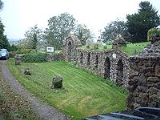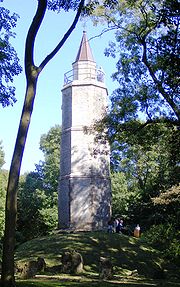
Banwell Caves
Encyclopedia
Banwell Caves are a 1.7-hectare
geological and biological Site of Special Scientific Interest near the village of Banwell
, North Somerset
, England notified in 1963.
The site comprises two caves, called 'Banwell Bone Cave' and 'Banwell Stalactite Cave', which lie within the grounds of a large house, at the western end of Banwell Hill. The caves contain barite
deposits, which are found in greater abundance and variety here than at any other site in the Mendip Hills
, and are used as a hibernation site by Greater Horseshoe Bat
s (Rhinolophus ferrumequinum).
The site also has several grotto
s and follies, including the Pebble summerhouse, Druid's Temple, an Osteoicon (or bone repository) and Banwell Tower which was completed in 1840.
to raise money for the local school. In an attempt to make access easier a tunnel was dug into the hill during which the bone cave was discovered in 1825.
The estate was owned by George Henry Law
as Bishop of Bath and Wells
, who thought the bones which were found were those of animals drowned in the flood at the time of Noah's Ark
described in the Book of Genesis. The bishop had paths and folly buildings created for visitors and built a small cottage, which later became his retirement home.
Since the 1970s preservation and restoration work has been undertaken.
s (including bear
, deer
, ox
, bison
and reindeer
) from the Pleistocene
era (approximately 80,000 years ago). The cave has a large hole in the roof and is believed to have been used as a pitfall trap.
The Bone Cave was discovered in 1824 during attempts to drive a horizontal passage into the Stalactite Cave. Archaeological excavation was carried out by William Beard, with some of the bones being removed but many being left in the cave in stacks.
between about 1824 and 1864.
 The 18 metres (59.1 ft) high, 3 stage tower, which is also known as the Banwell Monument or Banwell Pepperpot, was built in 1840 from local lias
The 18 metres (59.1 ft) high, 3 stage tower, which is also known as the Banwell Monument or Banwell Pepperpot, was built in 1840 from local lias
stone with some decoration in Bath Stone
. During World War II
it was used as a look out tower by the Home Guard. By the 1960s it was in a poor state of repair and could no longer been seen above the growing treetops. Local conservation groups undertook conservation work and it was reopened to the public in 1996. It is a Grade II listed building.
Hectare
The hectare is a metric unit of area defined as 10,000 square metres , and primarily used in the measurement of land. In 1795, when the metric system was introduced, the are was defined as being 100 square metres and the hectare was thus 100 ares or 1/100 km2...
geological and biological Site of Special Scientific Interest near the village of Banwell
Banwell
Banwell is a village and civil parish on the River Banwell in the North Somerset district of Somerset, England. Its population was 2,923 according to the 2001 census.-History:...
, North Somerset
North Somerset
North Somerset is a unitary authority in England. Its area covers part of the ceremonial county of Somerset but it is administered independently of the non-metropolitan county. Its administrative headquarters is in the town hall in Weston-super-Mare....
, England notified in 1963.
The site comprises two caves, called 'Banwell Bone Cave' and 'Banwell Stalactite Cave', which lie within the grounds of a large house, at the western end of Banwell Hill. The caves contain barite
Barite
Baryte, or barite, is a mineral consisting of barium sulfate. The baryte group consists of baryte, celestine, anglesite and anhydrite. Baryte itself is generally white or colorless, and is the main source of barium...
deposits, which are found in greater abundance and variety here than at any other site in the Mendip Hills
Mendip Hills
The Mendip Hills is a range of limestone hills to the south of Bristol and Bath in Somerset, England. Running east to west between Weston-super-Mare and Frome, the hills overlook the Somerset Levels to the south and the Avon Valley to the north...
, and are used as a hibernation site by Greater Horseshoe Bat
Greater Horseshoe Bat
The Greater Horseshoe Bat is a European bat of the Rhinolophus genus. Its distribution covers Europe, Africa, South Asia and Australia. It is the largest of the European Horseshoe Bats and is thus easily distinguished from other species...
s (Rhinolophus ferrumequinum).
The site also has several grotto
Grotto
A grotto is any type of natural or artificial cave that is associated with modern, historic or prehistoric use by humans. When it is not an artificial garden feature, a grotto is often a small cave near water and often flooded or liable to flood at high tide...
s and follies, including the Pebble summerhouse, Druid's Temple, an Osteoicon (or bone repository) and Banwell Tower which was completed in 1840.
History
The first cave to be discovered was the Stalactite cave in 1757. This was opened in 1824 as a show caveShow cave
Show caves — also called tourist caves, public caves, and in the United States, commercial caves — are caves that are managed by a government or commercial organization and made accessible to the general public, usually for an entrance fee...
to raise money for the local school. In an attempt to make access easier a tunnel was dug into the hill during which the bone cave was discovered in 1825.
The estate was owned by George Henry Law
George Henry Law
George Henry Law was the Bishop of Chester and then, from 1824, Bishop of Bath and Wells. He was the son of Edmund Law, Bishop of Carlisle....
as Bishop of Bath and Wells
Bishop of Bath and Wells
The Bishop of Bath and Wells heads the Church of England Diocese of Bath and Wells in the Province of Canterbury in England.The present diocese covers the vast majority of the county of Somerset and a small area of Dorset. The Episcopal seat is located in the Cathedral Church of Saint Andrew in...
, who thought the bones which were found were those of animals drowned in the flood at the time of Noah's Ark
Noah's Ark
Noah's Ark is a vessel appearing in the Book of Genesis and the Quran . These narratives describe the construction of the ark by Noah at God's command to save himself, his family, and the world's animals from the worldwide deluge of the Great Flood.In the narrative of the ark, God sees the...
described in the Book of Genesis. The bishop had paths and folly buildings created for visitors and built a small cottage, which later became his retirement home.
Since the 1970s preservation and restoration work has been undertaken.
Bone Cave
Banwell Bone Cave is 100 metres (328 ft) long and 20 m (66 ft) deep. The Bone Cavern itself is 8 m (26 ft) high and wide and 20 m long. It is approached through an early 19th century archway. It contains an assemblage of bones of mammalMammal
Mammals are members of a class of air-breathing vertebrate animals characterised by the possession of endothermy, hair, three middle ear bones, and mammary glands functional in mothers with young...
s (including bear
Bear
Bears are mammals of the family Ursidae. Bears are classified as caniforms, or doglike carnivorans, with the pinnipeds being their closest living relatives. Although there are only eight living species of bear, they are widespread, appearing in a wide variety of habitats throughout the Northern...
, deer
Deer
Deer are the ruminant mammals forming the family Cervidae. Species in the Cervidae family include white-tailed deer, elk, moose, red deer, reindeer, fallow deer, roe deer and chital. Male deer of all species and female reindeer grow and shed new antlers each year...
, ox
Ox
An ox , also known as a bullock in Australia, New Zealand and India, is a bovine trained as a draft animal. Oxen are commonly castrated adult male cattle; castration makes the animals more tractable...
, bison
Bison
Members of the genus Bison are large, even-toed ungulates within the subfamily Bovinae. Two extant and four extinct species are recognized...
and reindeer
Reindeer
The reindeer , also known as the caribou in North America, is a deer from the Arctic and Subarctic, including both resident and migratory populations. While overall widespread and numerous, some of its subspecies are rare and one has already gone extinct.Reindeer vary considerably in color and size...
) from the Pleistocene
Pleistocene
The Pleistocene is the epoch from 2,588,000 to 11,700 years BP that spans the world's recent period of repeated glaciations. The name pleistocene is derived from the Greek and ....
era (approximately 80,000 years ago). The cave has a large hole in the roof and is believed to have been used as a pitfall trap.
The Bone Cave was discovered in 1824 during attempts to drive a horizontal passage into the Stalactite Cave. Archaeological excavation was carried out by William Beard, with some of the bones being removed but many being left in the cave in stacks.
Stalactite Cave
Banwell Stalactite Cave is 240 m (787 ft) long and 75 m (246 ft) deep. Although no stream now runs through the cave, there is a deep lake in one of the chambers. The Stalactite Cave was entered by miners in 1757, and was a show caveShow cave
Show caves — also called tourist caves, public caves, and in the United States, commercial caves — are caves that are managed by a government or commercial organization and made accessible to the general public, usually for an entrance fee...
between about 1824 and 1864.
Banwell Tower

Lias Group
The Lias Group or Lias is a lithostratigraphic unit found in a large area of western Europe, including the British Isles, the North Sea, the low countries and the north of Germany...
stone with some decoration in Bath Stone
Bath Stone
Bath Stone is an Oolitic Limestone comprising granular fragments of calcium carbonate. Originally obtained from the Combe Down and Bathampton Down Mines under Combe Down, Somerset, England, its warm, honey colouring gives the World Heritage City of Bath, England its distinctive appearance...
. During World War II
World War II
World War II, or the Second World War , was a global conflict lasting from 1939 to 1945, involving most of the world's nations—including all of the great powers—eventually forming two opposing military alliances: the Allies and the Axis...
it was used as a look out tower by the Home Guard. By the 1960s it was in a poor state of repair and could no longer been seen above the growing treetops. Local conservation groups undertook conservation work and it was reopened to the public in 1996. It is a Grade II listed building.
External links
- www.banwellcaves.org - site maintained by the Banwell Caves Heritage Group
- Mendip Cave Registry and Archive - Banwell Caves

